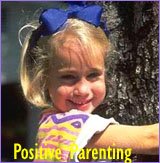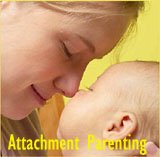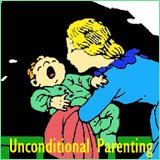Secure or Insecure Attachment in Infancy Largely Shapes Who We Are Today!
Secure attachment or insecure attachment?
Our instant interpretation leaves little doubt that secure attachment must be 'better' than insecure.
So far, so good ... but what do those concepts really mean and what is their relevance?
Well, let's start with the relevance of these attachment styles, because it's quite a biggie!
Our Mother's Care Our Two First Years Molds Our Personality
... To a Large Degree
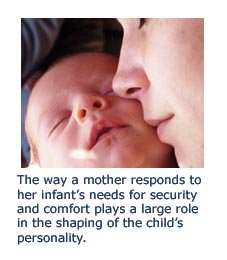
Attachment theory research and many other studies in the developmental psychology of children have shown that our very first close relationship with - or attachment to - our primary caregiver (typically our mother) the first two years of our lives shapes how we:
• View ourselves: our self esteem and self image ...
• See our place in the world and how we think other people see us ...
• Approach problems and cope with challenges, trauma and stress ...
• Establish and maintain friendships and romantic relationships ...
• Deal with strong emotions and impulses ...
... for the rest of our lives!
Of course, other factors also have a great say: individual temperaments, dispositions or social standing ...
... but numerous studies of the psychology of children show that the 'quality' of infant attachment – the way our mother responded to our need for comfort, security, attention etc. - is paramount in the shaping of our personality and how we deal with relationships.
Yes, it may seem quite overwhelming, and for some, even unfair that our mother's attention, responsiveness and sensitivity have such a strong influence on who we become.
Luckily Love Is a Powerful Healer
For instance, studies of Western families' adoption of Romanian orphans after the fall of Ceausescu demonstrated that proper love and care can heal a lot.
When these kids were in their teens, 70% of them were said to display no severe insecure attachment problems (which does not mean that there weren't insecure issues of attachment at all).
That is quite remarkable considering that as orphans they probably had little or no opportunity to form this important early attachment.
Attachment Behavior is the First Language of Survival
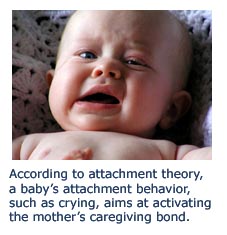
According to attachment theory, infants and young children communicate attachment behavior to get their mother's attention or to be in her proximity.
A mother's consistent response to these signals is necessary for the infant's physical survival and healthy psychological development.
Insecure and secure attachment refer to specific attachment behavior patterns that the infant shows, typically when being under some form of stress.
These patterns have been largely shaped by the mother’s sensitive responsiveness (secure attachment) – or lack or inconsistency of responsiveness (insecure attachment).
The character of a child's attachment behavior also changes as the child grows older (see typical attachment behavior through the ages and stages of child development)
Secure and Insecure Attachment Were Born in the Lab
Back in the 1960's developmental psychologist Mary Ainsworth developed a lab experiment called the Strange Situation Protocol.In this experiment she put a mother and her toddler in an unfamiliar playroom along with a female stranger.
Then the mother was to leave the room, leaving the child alone with the stranger.
After a few minutes the mother would return and reunite with her child.
These actions allowed Mary Ainsworth to observe separation and reunion behavior which would demonstrate whether a toddler was securely attached
or displayed one of three attachment styles characterized by
insecurity: avoidant attachment , ambivalent attachment or disorganized attachment.
Fulfilling an Infant's Needs Paves the Way for Secure Attachment
To put it very shortly, secure attachment can be achieved by quickly and consistently responding to your baby's signals and thereby fulfilling his or her needs!What an infant or child 'needs' from his or her parents are, among other things, attention, physical contact, presence, understanding, acceptance, comfort, a sense of security etc.
Insecure attachment is logically the result of the opposite situation - ignoring or inconsistently fulfilling the infant's needs.
If the basic existential needs are met, the child will be 'free': He or she will feel secure to explore the world, and consequently develop skills and feel the mastery of them, which builds self esteem etc.
The goal of attachment parenting and positive parenting is in fact to create secure attachment between mother or primary caregiver and child.
If the infant's needs are not met, and as a consequence, the child has formed an insecure attachment to his or her primary parent, life will obviously prove more difficult and challenging in several areas (some of these will be listed further down).
Secure Attachment:
- Positive Long Term Effects
Both long term studies of the psychology of children - and a
simple use of logic - tell us that secure attachment provides
positive effects: A happy child has a high chance of a happy
childhood and later, a happy life.
The scientifically documented effects of good, early secure attachment are:
- Basic trust
o The child has learnt that his or her needs will be met. Therefore they will expect help to be available and will therefore more easily reach out for it. - Positive self image and high self esteem
o The sensitive responses to and acceptance of the child's attachment behavior reflect back on the child: the positive way the parent sees and treats the child becomes the way the child sees and treats him- or herself. - Autonomy, good problem solving skills, goal orientation, determination
o The early exploration of the world within the mother's safe proximity (the technical word is 'secure base') has helped the child develop and create a sense of capability and mastery; 'I can do this and it makes me feel good about myself!' - Positive belief sets and outlook on life
o Securely attached children generally see the world as a non-threatening place and have an attitude of: 'People in general mean well and think nicely of me!'
- Strong relationships
o The mother's consistent, affectionate care-giving has paved the way for an ability to build and maintain long-term friendships and strong, healthy romantic relationships. Intimacy, trust and positive expectations are second nature. - Good coping strategies and skills
o A combination of hope, a positive outlook on life and good self esteem along with the ability to reach out for help and expect support, help securely attached children to cope better and faster with emotional challenges, stress and trauma.
- Good emotional control and behavior flexibility
o Children with secure attachment histories have more 'ego resiliency': They are good at adapting to new situations and controlling their impulses and emotions.
The Challenges of Insecure Attachment
Insecure attachment in infancy doesn't automatically mean that the child doesn't function normally – fortunately many do. However, studies reveal that there are some developmental patterns that seem to be typical of insecurely attached children:The lack of a 'secure base' in early childhood may mean:
- An 'non-meeting' of needs, limited exploration, skill development and subsequent feeling of mastery ...
- ... which may negatively influence the child's self image and self esteem
Avoidant Insecure Attachment:
- 'Emotions Don't Work and I Mustn't Rely on Anybody'
The scientifically documented effects of avoidant insecure attachment in infancy are: - Emotional detachment
o As an infant, the child has learnt that attachment behavior – or emotional expressions such as crying – is no good. It has no positive effect! So the child may not have developed much emotional awareness and may have a tendency to hide his or her feelings and not express negative emotions. - Lack of trust
o As a defence mechanism, an avoidant child will tend to not reach out for help because of his or her belief that no one will respond constructively.
- Relationship challenges
o Because of their 'distant' nature and restricted emotional availability among other things, it is often difficult to build and maintain long-term relationships – both in relation to friends and partners.
o Intimate relations are often characterized by fear; 'What if I end up being rejected (just like in infancy)? Then it’s better not to be too involved in the first place!'
o Avoidant adults may tend to bury themselves in work a as way to avoid dealing with people and relations.
Ambivalent Insecure Attachment:
- 'Short Emotional Fuse and Fear of Not Being 'Connected''
The scientifically documented effects of ambivalent insecure attachment in infancy are: - Having a hard time controlling behavior and emotions
o Compared with securely attached children, children with ambivalent insecure attachment tend to be less enthusiastic in their endeavours and experience and express more frustration and anger. - Confused self image
o Because of the mother’s inconsistent responses, the child is may be confused about his or her self image and often feels misunderstood or undervalued.
- Relationship challenges
o Because of the mother's sometimes sensitive, sometimes insensitive responsiveness, the child tends to be anxious by nature, concerned with and afraid of 'losing' the sense of 'connectedness' or union.
o This concern tends to be carried into love relationships and shows itself as obsession or strong jealousy.
o This concern may also make work life complicated in terms of for instance jealousy, desire for appreciation etc.
Disorganized Insecure Attachment:
- A Cause For Concern!
The category of disorganized insecure attachment in infancy is still quite new and is still being studied further to learn more about it. One thing that researchers found was that when compared with the other two attachment categories
(the insecure ones), children with disorganized attachment concerns are at more risk of developing aggressive behavior problems, which might already surface at the age of about five.
Please note that the above attachment styles and their outcome show the general picture, which means that individual exceptions are not included.
Therefore, use your critical eye! Don't take anything, any postulate, for granted.
Your Positive Parenting Ally,
Birgitte

Want to stay in touch and get the latest news?
Sign up
for my free newsletter
Parent Coaching
- For Inner Peace, Clarity and a Deeper Connection to Your Child
 Being a parent can feel like a double-edged sword. Life with kids may feel like the greatest gift you have ever received, while at the same being hugely challenging, often leaving you confused, stressed and overwhelmed.
Being a parent can feel like a double-edged sword. Life with kids may feel like the greatest gift you have ever received, while at the same being hugely challenging, often leaving you confused, stressed and overwhelmed.
When we feel like this, we've lost touch with ourselves. We can't hear our own inner voice, and it's difficult to know what is 'right' for us and how to act.
I offer in-depth parent coaching to help you regain your balance and get back in touch with yourself. From a place of inner peace and clarity, your will find your own answers which will help you reconnect with your child from a place of unconditional love and acceptance.
Read more about my parent coaching here.
Where Would You Like to Go Next?
Attachment Parenting Articles
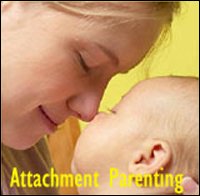 Attachment Parenting and Intuitive Parenting: Read Your Child Rather Than Some Book! |
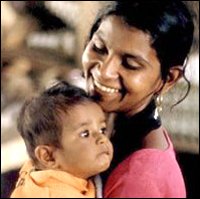 What Is Attachment Parenting? 10 Sharp Truths and 2 Common Misconceptions! |
Attachment Theory Articles (Scientific Angle)
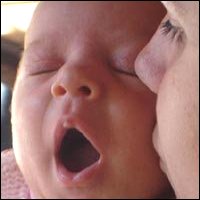 Psychology Attachment Behavior; Find out When to Expect the Constant Clinging or the Letting Go of Mom's Skirt! |
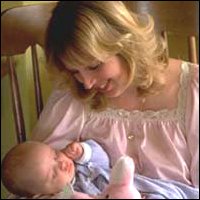 Attachment Theory is Good Basic Knowledge ... But Misses Out on Individual Infant Temperaments! |
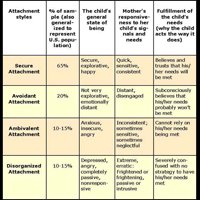 The Four Infant Attachment Styles: Straight to the Point, Quick Understanding! |
Attachment Experts
 John Bowlby: The Father of Attachment Theory |
 Mary Ainsworth: The Refiner of Attachment Theory |
 Deep Insights into the Essence Dr Sears' Attachment Parenting along with a Fascinating Historical View on the Slow Rising Consciousness of Attachment Parenting |
Attachment, High Need and Separation Anxiety
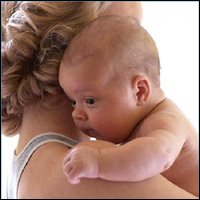 A High Need Baby: A Strong Personality Is Great, But Where's the Off Button? |
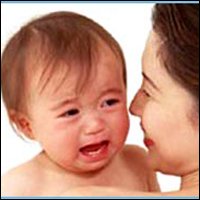 Baby Separation Anxiety The More Your Baby Clings, the More You Let Him! 10 Tips to Ease Baby Separation Anxiety |
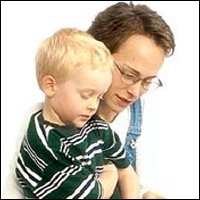 Valuable Insights into Separation Anxiety in Children and Babies: Meet Your Child with Full Acceptance and Deep Connection! |
 Facts and Fiction about the Controversial Ferber Method along with a Discussion of Its Potential Long Term Consequences |
Back to the top of this page about Secure or Insecure Attachment in Infancy Largely Shapes Who We Are Today!
Go to the Positive Parenting Ally Homepage




